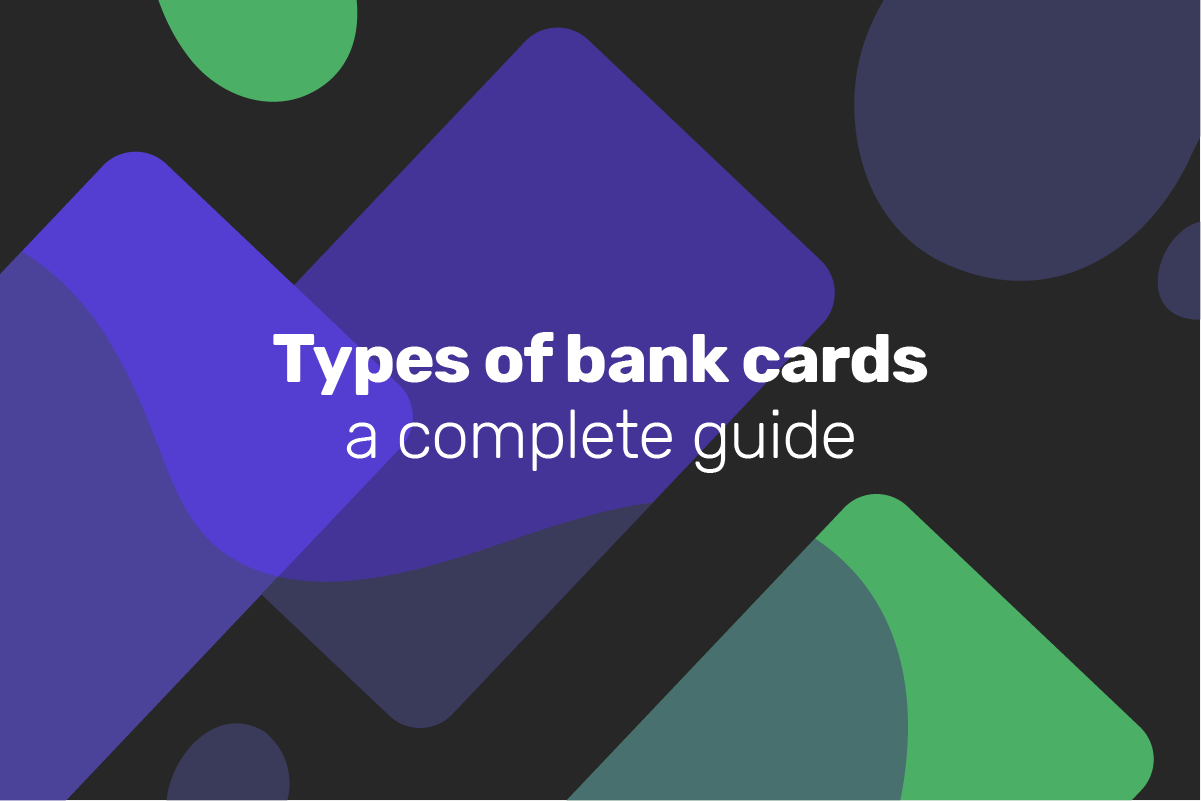Understanding the types of bank cards available can help you to see how they all prove helpful in different situations. The right bank cards can be used for more than just withdrawing cash from the ATM network.
We’ll be looking at the main differences between a credit or debit card, as well as prepaid cards and virtual cards. Find out the unique features and practical use cases for each of them. So, you get a clear comparison that lets you see which bank cards exist and what they do.
1. Credit cards
Credit cards allow you to borrow funds instantly. It’s like a short-term loan that can be used for purchases or to cover emergencies. These cards let you pay for purchases up to a pre-agreed credit limit, with interest charged if you don’t pay back the borrowed amount before the due date.
You may also use credit cards to make cash withdrawals up to your credit limit. However, expect to be charged a cash advance fee for doing this, regardless of when you pay it back.
The advantages of using credit cards are as follows.
A simple way to build credit. For a lot of people, this is the easiest way to get their first type of credit and start building a credit history. Secured credit cards are backed by cash deposits, giving someone with a poor credit history the chance to improve it.
Some credit cards offer useful rewards programs that can help you earn something extra when you use them.
The instant access to cash means that credit can be ideal for dealing with unexpected expenses.
There are also some potential drawbacks to take into account.
The interest rate on credit cards is often high.
It can lead to the accumulation of debt if not used correctly.
Look out for annual fees.
Understanding the best practices for credit cards will help you use them wisely. The most important point is in the grace period, which is the time following a purchase when you don’t need to pay any interest. It is when you should ensure that you pay the full balance.
Avoid using credit cards to withdraw cash, and take a moment to understand any rewards program you are joining. In fact, it makes sense to use the details of the interest rate and rewards program to help find the best credit cards for your needs. These are the most important factors to bear in mind when looking at which one to choose.
You don’t need to wait for the expiration date to switch to a new plastic card. It’s also worth looking for deals on balance transfer credit cards if you have an existing balance and want to lower your interest rate. The annual fee can vary between credit cards, which is another point to consider.
Open an account
in Genome online
2. Debit cards
A debit card is linked to your current account or savings account. It gives you direct access when you want to withdraw cash directly from your bank account, which is why some people use them mainly as ATM cards. You need to have enough money in the account to complete the transaction you want to make.
Unlike credit cards, you can’t accumulate debt with a debit card. You’re only accessing money in your bank account. Another advantage is that they allow immediate payment. These could be considered cash cards that give you a simple way to access funds in your bank account without the need to carry out a bank transfer or carry cash.
In terms of possible disadvantages, using debit cards can lead to overdraft fees if you withdraw more cash than is in your bank account. There’s also a more limited degree of dispute protection if you don’t agree with a transaction.
Budgeting is crucial with debit cards. It means that you should monitor the balance regularly. Another option is to set up alerts that let you see when your debit card has been used. You can add your card to a mobile phone digital wallet like Apple Pay or Google Pay, giving you a faster way to make contactless payments.
3. Prepaid cards
Prepaid cards differ from credit or debit cards in how you load funds to use. You can then spend only the loaded amount, with no credit limit or link to the money in your bank account. If you want to spend more, this is processed manually by loading more funds.
Prepaid cards provide a smart alternative for someone who wants to have tight control over their spending. This is why travelers and younger users are among the users who most use prepaid cards. They can also be an alternative for someone who can’t get a debit or credit card from a financial institution or bank.
Loading fees, monthly maintenance fees, and other fees may be charged. Be sure to check the fee structure before using prepaid cards. You should also consider the limits you might need for them. If you’re looking at prepaid cards for travel purposes, it’s important that you consider the currency that’s going to be most useful, as well as the expiration date.
4. Virtual cards
Virtual cards can fit into any previous categories (prepaid card, credit or debit card). These are non-physical payment cards that can’t be used for ATM cash withdrawals and are mainly used to make online payments. They don’t take the form of a plastic card with the card issuer logo, but they can still be used in many of the same ways.
Compared to a physical card, a virtual card offers additional security features. Unique card numbers are generated on each transaction through tokenization. It reduces the risk of fraud by keeping the card details secure.
Virtual payment cards can be an alternative to physical bank cards in certain situations. They provide a way to pay for online purchases safely. This payment method is worth considering for recurring payments, such as subscription payments or regular business expenses automatically deducted monthly.
These payment cards carry an expiration date like a physical card. However, new card verification and renewal can be done online. New details are generated online, meaning that the new card can be used immediately.
Open an account
in Genome online
Key differences and how to decide
The main differences between these cards include the ease of use for online payments. While most payment cards can be used for online purchases, virtual cards are designed to be easier and more secure.
In terms of credit limits, credit cards provide access to the pre-agreed amount of credit. A debit card can be used with the overdraft limit on the linked bank account. Prepaid bank accounts only work to use or withdraw money but can’t be used to spend borrowed money.
A debit card can be used to access the interest and other funds in the savings or checking account linked to it. Therefore, one of the main differences to bear in mind is the level of spending control each bank card allows. It means that you should consider factors like your financial habits and what stage you’re at in the journey to building your credit score.
The primary purpose of each type of card
This table explains the main purpose of all the different cards, which could be called payment cards or ATM cards.
Type of bank card | Primary purpose |
Debit card | Easy access to funds in a linked bank account |
Credit card | Instant access to credit, up to a pre-agreed limit |
Prepaid card | Spending preloaded funds |
Virtual card | Online purchases and transactions |
Tips for choosing the right bank card
The variety of bank cards means you should consider which is right for you. It involves evaluating your personal and business needs. Key factors include the monthly fees for using these cards or any interest charges.
With credit cards, you’ll want to see what reward programs are offered and whether the interest rate and grace period suit you. It’s also a good idea to see if you have the choice of virtual or physical cards from the issuing bank. Always check the fine print when looking at the offers for credit and debit cards. It will help you make the right choice and avoid hidden charges.
If you plan to hold multiple cards, you should consider your overall needs. Having too many bank cards can lead to high fees. You might also damage your credit score if you don’t stay up to date with them and are charged a late payment fee on a credit card.
Cards and account features from Genome
Choosing the right bank cards is made easier when you find a reliable financial institution first. Why not try Genome? We are licensed by the Bank of Lithuania and offer a wide range of personal and business features online.
Genome provides virtual and physical debit Visa cards for all our clients. All our cards can be ordered online with just a few clicks and are used for on-the-go, online, and contactless payments. Moreover, our cards work perfectly with Genome’s multi-currency accounts. You can link your cards to accounts in USD, GBP, EUR, PLN, CHF, CZK, HUF, and SEK.
A dedicated IBAN account and currency exchange options are also available, helping you to manage your daily finances securely.
The user-friendly services provided by Genome allow for smooth transactions and easy money management.
Open an account
in Genome online
Get the right bank cards for your needs and habits
Credit cards are useful for accessing borrowed money, like a revolving loan, you pay back every month. Meanwhile, debit cards let you withdraw money from your bank account. A prepaid card only gives you access to the cash you load, so you need to add more money to keep using it. A virtual card is a secure online payment method that hides your real card number.
Each of these card types can be used to withdraw funds or as a flexible payment method. The question of which one suits you best comes down to your individual needs and spending habits. Are you most likely to make in-person purchases in stores or ATM withdrawals? Do you need high, flexible spending limits? Or just sufficient funds for small purchases?
By considering your card use and financial goals, you can decide what cards you need to ask your card issuer to provide you with.
FAQs
Can I have more than one type of bank card at the same time?
Yes, some users have various debit and credit cards. You might also want a mixture of virtual and physical cards, as well as a prepaid card.
Are virtual cards accepted everywhere online?
Virtual cards are accepted as an online payment method in the same way as physical cards. You just need to look for a site that accepts the card network you want to use (Visa, MasterCard, etc).
How do I dispute a transaction on a prepaid card?
It’s a good idea to speak to the merchant first to see if the matter can be resolved. If not, you should contact the card issuer to dispute the transaction.
Will having multiple credit cards hurt my credit score?
Having credit cards can help boost your credit score, as it means you’re using more of the credit available to you. However, it could have a negative impact if you use your credit cards unwisely, with an unpaid balance or other issues.
What happens if my virtual card gets compromised?
You should contact the card issuer immediately to make sure that the outstanding balance on the card can’t be used. A new card will be issued to replace the compromised card.
Are business debit cards different from personal debit cards?
Business and personal cards work similarly but are either linked to a business account or a personal account. A business card might have higher spending limits or more cards linked to a single business account.






